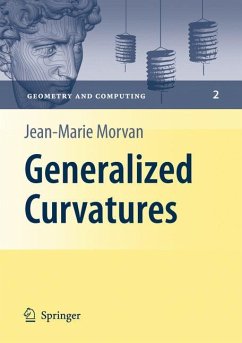The intent of this book is to set the modern foundations of the theory of generalized curvature measures. This subject has a long history, beginning with J. Steiner (1850), H. Weyl (1939), H. Federer (1959), P. Wintgen (1982), and continues today with young and brilliant mathematicians. In the last decades, a renewal of interest in mathematics as well as computer science has arisen (finding new applications in computer graphics, medical imaging, computational geometry, visualization ...).
Following a historical and didactic approach, the book introduces the mathematical background of the subject, beginning with curves and surfaces, going on with convex subsets, smooth submanifolds, subsets of positive reach, polyhedra and triangulations, and ending with surface reconstruction. We focus on the theory of normal cycle, which allows to compute and approximate curvature measures of a large class of smooth or discrete objects of the Euclidean space. We give explicit computations when the object is a 2 or 3 dimensional polyhedron.
This book can serve as a textbook to any mathematician or computer scientist, engineer or researcher who is interested in the theory of curvature measures.
The central object of this book is the measure of geometric quantities describing N a subset of the Euclidean space (E ,), endowed with its standard scalar product. Let us state precisely what we mean by a geometric quantity. Consider a subset N S of points of the N-dimensional Euclidean space E , endowed with its standard N scalar product. LetG be the group of rigid motions of E . We say that a 0 quantity Q(S) associated toS is geometric with respect toG if the corresponding 0 quantity Q[g(S)] associated to g(S) equals Q(S), for all g?G . For instance, the 0 diameter ofS and the area of the convex hull ofS are quantities geometric with respect toG . But the distance from the origin O to the closest point ofS is not, 0 since it is not invariant under translations ofS. It is important to point out that the property of being geometric depends on the chosen group. For instance, ifG is the 1 N group of projective transformations of E , then the property ofS being a circle is geometric forG but not forG , while the property of being a conic or a straight 0 1 line is geometric for bothG andG . This point of view may be generalized to any 0 1 subsetS of any vector space E endowed with a groupG acting on it.
Following a historical and didactic approach, the book introduces the mathematical background of the subject, beginning with curves and surfaces, going on with convex subsets, smooth submanifolds, subsets of positive reach, polyhedra and triangulations, and ending with surface reconstruction. We focus on the theory of normal cycle, which allows to compute and approximate curvature measures of a large class of smooth or discrete objects of the Euclidean space. We give explicit computations when the object is a 2 or 3 dimensional polyhedron.
This book can serve as a textbook to any mathematician or computer scientist, engineer or researcher who is interested in the theory of curvature measures.
The central object of this book is the measure of geometric quantities describing N a subset of the Euclidean space (E ,), endowed with its standard scalar product. Let us state precisely what we mean by a geometric quantity. Consider a subset N S of points of the N-dimensional Euclidean space E , endowed with its standard N scalar product. LetG be the group of rigid motions of E . We say that a 0 quantity Q(S) associated toS is geometric with respect toG if the corresponding 0 quantity Q[g(S)] associated to g(S) equals Q(S), for all g?G . For instance, the 0 diameter ofS and the area of the convex hull ofS are quantities geometric with respect toG . But the distance from the origin O to the closest point ofS is not, 0 since it is not invariant under translations ofS. It is important to point out that the property of being geometric depends on the chosen group. For instance, ifG is the 1 N group of projective transformations of E , then the property ofS being a circle is geometric forG but not forG , while the property of being a conic or a straight 0 1 line is geometric for bothG andG . This point of view may be generalized to any 0 1 subsetS of any vector space E endowed with a groupG acting on it.
From the reviews: "This book is a welcome addition to the literature in differential geometry. The main aim of this book is the measure of geometric quantities describing a subset of the Euclidean space ... endowed with its standard scalar product. ... The book contains 107 figures and the bibliography contains about 89 entries. The book covers an active, interesting and fresh research area. It is very useful for researchers in differential geometry and related subjects." (Kazim Ilarslan, Zentralblatt MATH, Vol. 1149, 2008)








